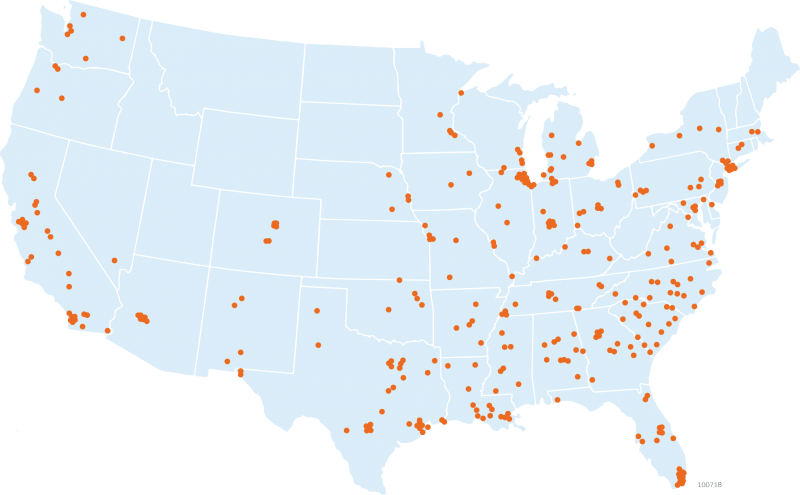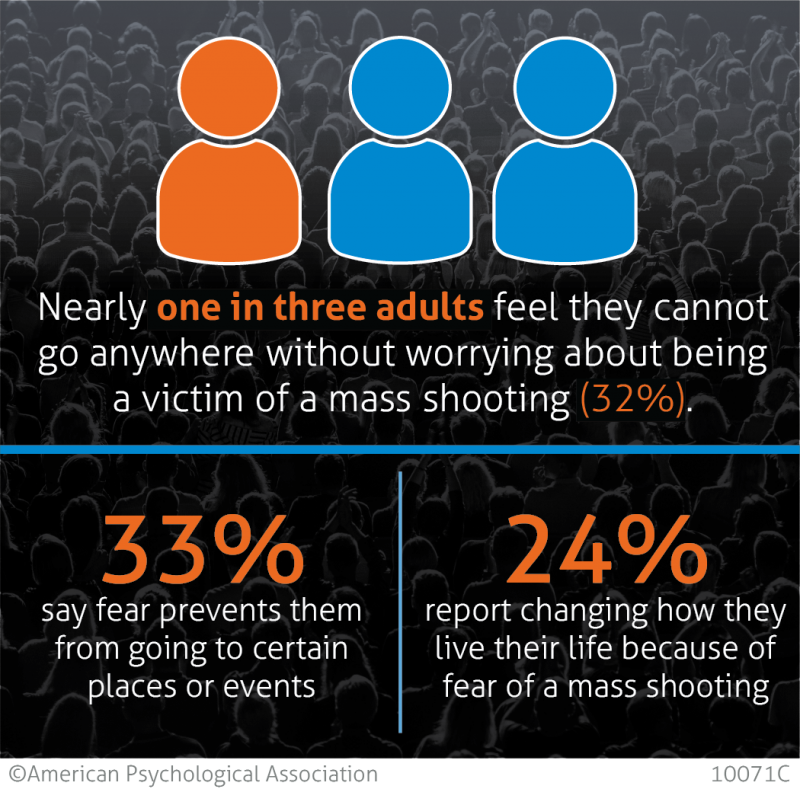Media Impact on Mental Health
How Exposure to Mass Violence in the Media Can Negatively Impact Your Mental Health and What to Do About It
By Jenna Berkwit
Recent studies show what some may have already guessed: media exposure on violent or traumatic events such as mass murders may result in negative mental health outcomes. As instances of mass murders increase in the United States (2), so too does media coverage and the likelihood that continued viewing could lead to symptoms such as anxiety, acute stress, and posttraumatic stress disorder (PTSD) (3, 5).
Mass Murders Increase Over Time
The government defines mass murder as “3 or more killings in a single incident” in a public place (19). The United States has experienced a dramatic increase in mass murder occurrences in recent years. From 1982 to 2011, there was an average of one mass murder every 172 days. In 2011, that average decreased to one mass murder every 64 days (7). During the first half of 2022, there were eight mass murders and 56 fatalities (16).
 Courtesy of: http://assets.motherjones.com/politics/2014/10/harvard_timeline_1260.png
Courtesy of: http://assets.motherjones.com/politics/2014/10/harvard_timeline_1260.png
When expanding the data to include mass shootings that did not result in a fatality, mass shooting rates become staggering. According to the Gun Violence Archive, a not-for-profit organization dedicated to compiling data on gun-related violence, there have been 418 mass shootings in the United States with at least one mass shooting each week since the beginning of 2022. (8, 14). The map below depicts the number of mass shootings in the United States from January 1, 2022, through August 16, 2022.
 Mass Shootings in US 2022 – January 1 – August 16
Mass Shootings in US 2022 – January 1 – August 16
The Problem
Media Coverage of Mass Violence
The sensationalism of mass shooting events combined with a 24-hour news cycle and social media results in extensive and pervasive coverage of graphic content. The New York times featured each of the past 10 deadliest mass shootings on its front page for an entire week, and the lethality or shock value of the tragedy can extend the coverage of the event (8). For example, the top three news networks ran 140 news segments after the Las Vegas massacre, and the 1999 Columbine shooting garnered a larger media audience than “both the 1992 and 1996 presidential elections, the Rodney King verdict and LA riots, the Iraqi invasion of Kuwait, and the deaths of Princess Diana and Mother Teresa” (22, 14).
News outlets use criteria such as total fatalities, if the site of the incident was a “safe” space such as a mall or school, and unique characteristics of the shooting to determine which events to cover (5). The use of these criteria results in public exposure to the most violent and fear-inducing events.
Promulgation of Violence
Media coverage of mass shootings and other exceptionally violent events not only incite fear, but at times perpetuate further violence. The near constant airing of violent and graphic images, the multiple mentions of the shooter’s name, and other repeated details of the event such as the weapon used can lead to copycat or similar incidents within the first 14 days after the original event. This phenomenon of an increased likelihood of mass killings and/or suicides after media coverage of a mass shooting is known as the contagion effect (17). After media coverage of a mass shooting, studies have found an average of three mass shootings occur within the following two weeks (13). To think of it another way, that is “58% of all mass shootings in the United States” (13). As the victim count increases, so too does fear and anxiety in the community.
Exposure Effects on the Individual
While violent and other traumatic events have a direct impact on the survivors and surrounding community, they can also affect those viewing the media coverage. The American Psychological Association’s (APA’s) 2019 “Stress in America” annual survey found that one in three adults are staying home for fear of mass shootings and being in public places such as malls, schools, and movie theaters (3).
I n addition to the development of avoidant behaviors, there is also a link between exposure to real, traumatic events and anxiety, acute stress, and PTSD. Consider the following research studies:
n addition to the development of avoidant behaviors, there is also a link between exposure to real, traumatic events and anxiety, acute stress, and PTSD. Consider the following research studies:
- Individuals who read a news item on mass shootings were more likely to experience anxiety compared to those who read a “filler” article (17).
- People experienced acute stress due to prolonged media exposure to both the Sandy Hook school shooting and the Boston Marathon bombings (12).
- PTSD was more likely to be present in people who viewed more images on the 9/11 attacks than those who did not (2).
- Children who viewed images of the 1995 OKC bombing (and were geographically local) were more likely to have symptoms of PTSD (12).
When individuals have acute stress or anxiety after exposure to traumatic images, what they experience often goes beyond mental symptoms such as feelings of fear, panic, and impending doom. There is a physical component to the anxiety with symptoms ranging from difficulty sleeping, sweating, and feeling week to gastrointestinal problems, shortness of breath, and even heart palpitations (4). Given the mental and physical effects of anxiety in response to viewing traumatic images, it would reason that people would purposefully avoid any media of mass violent events, but the opposite often occurs. While repeated exposure to these events proves most harmful, oftentimes individuals will continue viewing this content as a means of reducing their stress and anxiety.
Cycle of Distress
In the aftermath of these events, people often seek out information to make sense of what happened and to allay their fears by attempting to exert control over their situation (6). This information-seeking strategy often works in other situations, however, in the case of violent or traumatic events, the information gained does not alleviate uncertainty or fear, as often the information contains graphic images or upsetting content. This then can lead to additional information seeking, renewed fear, and the development of a “cycle of distress” (26). The use of social media for real-time updates during times of crisis can also exacerbate the cycle.
Doomscrolling
Social media platforms can provide the public with breaking news, which is often unfiltered. Access to this content may result in users engaging in “doomscrolling” during times of prolonged negative news events. Doomscrolling refers to “media use typically characterized as individuals persistently scrolling through their social media newsfeeds with an obsessive focus on distressing, depressing, or otherwise negative information” (22). According to a recent survey on the consumption of pandemic-related news, those who spent more time viewing it than others also reported “higher levels of anxiety, distress, stress, and depression” (6).
Risk Factors
While repeated media exposure to violent and traumatic events can have negative mental health outcomes on all populations, research shows there are groups more likely to experience stress over the possibility of mass shootings (3).
Most Stressed by Possibility of Mass Shootings:
- Women
- Hispanic adults
- African American adults
- Parents with children under the age of 18
Acute Stress Risk
When there is prolonged media exposure to tragic events, people with prior mental health issues are more likely to experience acute stress. Similarly, there was a cumulative effect to these types of events meaning that prolonged exposure to more than one event increased the likelihood one would experience acute stress. (12).
Coping & Prevention Techniques
Coping with the impact of mass violence while also wanting to stay informed is a daunting task. The following suggested practices can ease the fear felt by these events and prevent a cycle of distress or doomscrolling.
- Identify and accept feelings. Feelings of fear or stress are valid and should not be pushed away (21).
- Practice self-care. It is important to maintain healthy habits such as getting enough rest, exercise, drinking water and eating nutritious meals, especially during times of heightened stress (24).
- Check responses to media exposure. Feelings of physical or emotional tension can be a sign it is time to take a break (24).
- Limit media sources. Stick to a few trusted news sources, or even one source to avoid consuming too much negative content (24).
- Prevent doomscrolling. Filter social media feeds to exclude unwanted content by using a hashtag filter (21).
- Get involved: Joining an organization dedicated to ending mass violence, writing political leaders, or donating to people affected by the crisis can lessen feelings of helplessness (24).
- Use resources for talking about mass shootings with kids. Talking with children and youth about mass shootings is difficult, however, credible resources exist to help make the discussion easier.
- Parent & Caregiver Resources: The Center for the Study of Traumatic Stress provides a free tip sheet for parents entitled, “Restoring a Sense of Safety in the Aftermath of a Mass Shooting” (20), and PBS offers a guide on how to discuss tragic events in the news with children (11).
- Counseling Professional Resources: The National Child Traumatic Stress Network (NCTSN) offers school personnel toolkits, videos, and tips sheets to aid children dealing with traumatic events (25). Additionally, the American School Counselor Association (ASCA) provides members with access to webinars and articles with information on how to provide better support to students after a school/community shooting (1).
- Seek help when needed. Reach out to a licensed mental health expert when feelings of sadness, anger, or worry over mass violent events begin to impact daily life (21).
Magellan Federal Support
Magellan has effective and innovative solutions federal employees and military members can utilize to cope with exposure to mass shootings and other traumatic events.
- EAP Counselors – For 50 years, Magellan has provided services to more than three million members, helping them with stress management and emotional wellness.
- Military & Family Life Counselors – 1,400 licensed counselors provide nonmedical services to military members and their families at more than 160 installations around the world. Each year, more than 4,500,000 service members and families benefit from MFLC services.
- NeuroFlow – Magellan Federal has provided this health and wellness smartphone application to service members and their families at three installations. Participants benefit from self-directed resources and tools along with support from an on-site MFLC counselor.
- Master Resiliency Trainers – Magellan Federal has more than 15,000 Master Resilience Trainers who have delivered education and training to more than 2.6 million in the Army population.
Recommended Resources
- Substance Abuse and Mental Health Services Administration Helpline: Crisis support service for anyone experiencing emotional distress related to natural and manmade disasters:
- Phone: 800-985-5990
- Text: TalkWithUs to 66746
- Spanish speakers text ‘Hablanos’ to 66746
- Articles for dealing with trauma, including responses of children
- Article: “Recovering emotionally after a disaster or stressful life event”
- Article: “From Pain to Purpose: 5 Ways to Cope in the Wake of Trauma”
- Article: “Talking to Children About Violence: Tips for Parents and Teachers” – National Association of School Psychologists
- Talking points and guidance for discussing school shootings and terrorist attacks with children
- Article: “Age-Related Reactions to a Traumatic Event”
- Article: “Helping Youth to Cope with 4th of July Celebrations After a Shooting”

Jenna Berkwit is a Senior Quality Improvement Manager on Magellan Federal’s Military Family Life Counseling program. She received a bachelor’s degree in Communication from Western Illinois University and has more than 15 years’ experience in quality improvement with the past nine in the healthcare field.
She is an ISO 9001 Certified Internal Auditor and an active member in the American Society for Quality (ASQ).
Cited References
- After a School Shooting Resources – American School Counselor Association (ASCA). (2022). American School Counselor Association. https://www.schoolcounselor.org/Publications-Research/Publications/Free-ASCA-Resources/After-a-School-Shooting
- Ahern, J., Galea, S., Resnick, H., & Vlahov, D. (2004). Television Images and Probable Posttraumatic Stress Disorder After September 11. Journal of Nervous & Mental Disease, 192(3), 217–226. https://doi.org/10.1097/01.nmd.0000116465.99830.ca
- American Psychological Association. (2019, August 15). One-Third of US Adults Say Fear of Mass Shootings Prevents Them from Going to Certain Places or Events. APA.Org. https://www.apa.org/news/press/releases/2019/08/fear-mass-shooting
- Anxiety disorders – Symptoms and causes. (2018, May 4). Mayo Clinic. Retrieved September 15, 2022, from https://www.mayoclinic.org/diseases-conditions/anxiety/symptoms-causes/syc-20350961
- Barr, J., & Izadi, E. (2022, July 9). There are too many mass shootings for the U.S. media to cover. Washington Post. https://www.washingtonpost.com/media/2022/07/09/us-media-mass-shootings/
- Buchanan, K. (2021, October 13). Brief exposure to social media during the COVID-19 pandemic: Doom-scrolling has negative emotional consequences, but kindness-scrolling does not. PLOS ONE. https://journals.plos.org/plosone/article?id=10.1371/journal.pone.0257728
- Follman, M., Pauly, M., Friedman, D., Corn, D., Dias, I., Weinberg, A., Vesoulis, A., & Levy, P. (2014, October 15). Rate of mass shootings has tripled since 2011, new research from Harvard shows. Mother Jones. https://www.motherjones.com/politics/2014/10/mass-shootings-increasing-harvard-research/
- Gun Violence Archive. (2022, July 15). Mass Shootings in 2022 [Map]. Gun Violence Archive. https://www.gunviolencearchive.org/query/0484b316-f676-44bc-97ed-ecefeabae077/map
- Harris, A. (2018, November 16). How Long Does the Media Cover Mass Shootings? The Atlantic. https://www.theatlantic.com/education/archive/2018/11/how-long-does-media-cover-mass-shootings/575926/
- Harvard School of Public Health. (n.d.). Time Between Mass Shootings, 1982–2014 [Graph]. http://assets.motherjones.com/politics/2014/10/harvard_timeline_1260.png
- Helping Children with Tragic Events in the News | Parenting Tips & Advice. (2018, February 12). PBS KIDS for Parents. https://www.pbs.org/parents/thrive/helping-children-with-tragic-events-in-the-news?fbclid=IwAR04ONybPf1YmQQs82f6Co5PUbh5Kg4Sw0mFPbE1aI3vM894QSc93BFR0b8
- Holman, E. A., Garfin, D. R., & Silver, R. C. (2013). Media’s role in broadcasting acute stress following the Boston Marathon bombings. Proceedings of the National Academy of Sciences, 111(1), 93–98. https://doi.org/10.1073/pnas.1316265110
- Jetter, M., & Walker, J. K. (2017, October). The effect of media coverage on mass shootings. IZA Institute of Labor Economics, 11900. https://www.iza.org/publications/dp/11900/the-effect-of-media-coverage-on-mass-shootings
- Lankford, A., & Madfis, E. (2018). Media Coverage of Mass Killers: Content, Consequences, and Solutions. American Behavioral Scientist, 62(2), 151–162. https://doi.org/10.1177/0002764218763476
- Ledur, J., Rabinowitz, K., & Galocha, A. (2022, July 5). There have been over 300 mass shootings so far in 2022. Washington Post. https://www.washingtonpost.com/nation/2022/06/02/mass-shootings-in-2022/
- Mother Jones. (n.d.). Mother Jones – Mass Shootings Database, 1982 – 2022. Google Docs. https://docs.google.com/spreadsheets/d/1b9o6uDO18sLxBqPwl_Gh9bnhW-ev_dABH83M5Vb5L8o/edit#gid=0
- O’Brien, C., & Kanako, T. (2022, February). Alpha and beta changes in anxiety in response to mass shooting related information. Science Direct. https://www.sciencedirect.com/science/article/abs/pii/S0191886921007054?via%3Dihub
- Pescara-Kovach, L. (2017). The Contagion Effect as it Relates to Public Mass Shootings and Suicides. Journal of Campus Behavioral Intervention, 5, 36. https://www.researchgate.net/profile/Jonathan-Silk-2/publication/321181410_Redesigning_Care_Using_Design_Thinking_to_Restructure_the_Care_Team/links/5a139d75aca27217b5a3016a/Redesigning-Care-Using-Design-Thinking-to-Restructure-the-Care-Team.pdf#page=39
- Public Law 112–265. (2013, January 14). Investigative Assistance for Violent Crimes Act of 2012. https://www.govinfo.gov/content/pkg/PLAW-112publ265/html/PLAW-112publ265.htm
- Restoring a Sense of Safety in the Aftermath of a Mass Shooting: Tips for Parents and Professionals. (2022). Center for the Study of Traumatic Stress. https://www.cstsonline.org/resources/resource-master-list/restoring-a-sense-of-safety-in-the-aftermath-of-a-mass-shooting-tips-for-parents-and-professionals
- Sager, J. (2022, July 6). Therapists Share Their Best Tips for Coping With the Fear and Anxiety That Comes With Gun Violence. Parade: Entertainment, Recipes, Health, Life, Holidays. https://parade.com/1389773/jessicasager/gun-violence-anxiety/
- Sharma, B. (2022, January 10). The Dark at the End of the Tunnel: Doomscrolling on Social Media Newsfeeds · Volume 3, Issue 1: Spring 2022. Technology, Mind, and Behavior. https://tmb.apaopen.org/pub/nn9uaqsz/release/1?readingCollection=b3f70ac4
- Study: Lessons for the media following the worst mass shooting in modern U.S. history. (2017, November 14). Media Matters for America. https://www.mediamatters.org/nbc/study-lessons-media-following-worst-mass-shooting-modern-us-history
- Swaim, E. (2022, June 7). 7 Tips for Navigating Media After a Mass Shooting. Healthline. https://www.healthline.com/health/mental-health/navigating-media-after-a-shooting#takeaway
- Talking to Children about the Shooting. (2022, May 26). The National Child Traumatic Stress Network. https://www.nctsn.org/resources/talking-children-about-shooting
- Thompson, R., Jones, N., Jones, Holman, E. A., & Cohen Silver, R. (2019, April 17). Media exposure to mass violence events can fuel a cycle of distress. Science Advances. https://www.science.org/doi/10.1126/sciadv.aav3502?cookieSet=1
